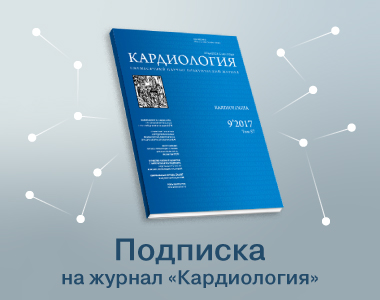Intracellular Molecular Mechanisms of Adrenergic Regulation of Pulmonary Vein Myocardium Membrane Potential
https://doi.org/10087/cardio.2017.11.10052
Abstract
About the Authors
V. M. KarimovaRussian Federation
V. S. Kuzmin
Russian Federation
L. V. Rosenshtraukh
Russian Federation
References
1. Masani F. Node-like cells in the myocardial layer of the pulmonary vein of rats: an ultrastructural study. J. Anat 1986;145:133-142.
2. Haissaguerre M., Jais P., Shah D. C. Spontaneous initiation of AF by ectopic beats originating in the pulmonary veins. N. Engl J. Med 1998;339:659-66.
3. Doisne N., Maupoil V., Cosnay P., Findlay I. Catecholaminergic automatic activity in the rat pulmonary vein: electrophysiological differences between cardiac muscle in the left atrium and pulmonary vein. Am J. Physiol Heart Circ Physiol 2009;297:102-108.
4. Chen Y. J., Chen S. A., Chang M. S., Lin C. I. Arrhythmogenic activity of cardiac muscle in pulmonary vein 3s of the dog: Implication for the genesis of atrial fibrillation. Cardiovasc Res 2000;48:265-273.
5. Cheung D. W. Electrical activity of the pulmonary vein and its interaction with the right atrium in the guinea-pig. J. Physiol 1980;314;:445-456.
6. Tsuneoka Y., Kobayashi Y., Honda Y. et al. Electrical activity of the mouse pulmonary vein myocardium. J. Pharmacol Sci 2012;119:287-292.
7. Maupoil V., Bronquard C., Freslon J. L. et al. Ectopic activity in the rat pulmonary vein can arise from simultaneous activation of alpha,- and beta1-adrenoceptors. Br J. Pharmacol 2007;150:899-905.
8. Бернгардт Э. Р. Роль автономной нервной системы в развитии фибрилляции предсердий. Бюллетень федерального центра сердца, крови и эндокринологии им. В. А. Алмазова 2011;1:68-71.
9. Ehrlich J. R., Cha T. J., Zhang L. et al. Cellular electrophysiology of canine pulmonary vein cardiomyocytes: action potential and ionic current properties. J. Physiol 2003;551:801-813.
10. Heijman J., Voigt N., Nattel S., Dobrev D. Cellular and Molecular Electrophysiology of Atrial Fibrillation Initiation, Maintenance, and Progression. Circ Res 2014;114:1483-1499.
11. Tan A. Y., Li H., Wachsmann-Hogiu S. et al. Autonomic innervation and segmental muscular disconnections at the human pulmonary vein-atrial junction: implications for catheter ablation of atrial-pulmonary vein junction. J. Am Coll Cardiol 2006;48:132-143.
12. Кузьмин В. С., Абрамочкин Д. В., Сухова Г. С., Ашмарин И. П. Изучение рецепторных механизмов действия АДФ-рибозы в сердце крысы. Нейрохимия 2008;2:23-32.
13. Кузьмин В. С., Абрамочкин Д. В., Сухова Г. С., Розенштраух Л. В. Влияние АДФ-рибозы, АМФ и аденозина на электрическую активность в предсердии и папиллярной мышцы гибернирующего суслика. Кардиология 2008;48:53-60.
14. Saucerman J.J., McCulloch A. D. Cardiac beta-adrenergic signaling: from subcellular microdomains to heart failure. Ann N Y Acad Sci 2006;1080:348-361.
15. Xiao R., Zhu W., Zheng M. et al. Subtype-specific α1- and β-adrenoceptor signaling in the heart. Trends in Pharmacological Sciences 2006;27:330-337.
16. Clapham D. E. Direct G protein activation of ion channels. Annu Rev Neurosci 1994;17:441-464.
17. Fischmeister R., Castro L. R., Abi-Gerges A. et al. Compartmentation of cyclic nucleotide signaling in the heart: the role of cyclic nucleotide phosphodiesterases. Circ Res 2006;99:816-828.
18. St Clair J. R., Liao Z., Larson E. D., Proenza C. PKA-independent activation of I (f) by cAMP in mouse sinoatrial myocytes. Channels (Austin) 2013;7:318-321.
19. Cui J., Melman Y., Palma E. et al. Cyclic AMP regulates the HERG K(+) channel by dual pathways. Curr Biol 2000;10:671-674.
20. Seino S., Shibasaki T. PKA-dependent and PKA-independent pathways for cAMP-regulated exocytosis. Physiol Rev 2005;85:-1303-1342.
21. O'Connell T. D., Jensen B. C., Baker A.J., Simpson P. C. Cardiac alpha1-adrenergic receptors: novel aspects of expression, signaling mechanisms, physiologic function, and clinical importance. Pharmacol Rev 2013;66:308-333.
22. Steinberg S. F. Cardiac actions of protein kinase C isoforms. Physiology (Bethesda) 2012;27:130-139.
23. Mier K., Kemken D., Katus H. A. et al. Adrenergic activation of cardiac phospholipase D: role of alpha(1) - adrenoceptor subtypes. Cardiovasc Res 2002;54:133-139.
24. Balboa M. A., Insel P. A. Stimulation of phospholipase D via alpha1-adrenergic receptors in Madin-Darby canine kidney cells is independent of PKCalpha and -epsilon activation. Mol Pharmacol 1998;53:221-227.
25. Li L., Zhang X. Differential inhibition of the TRPM8 ion channel by Gaq and Ga 11. Channels (Austin) 2013;7:115-118.
26. Chen X., Talley E. M., Patel N. et al. Inhibition of a background potassium channel by Gq protein alpha-subunits. Proc Natl Acad Sci 2006;103:3422-3427.
27. Anumonwo J. M., Lopatin A. N. Cardiac strong inward rectifier potassium channels. J Mol Cell Cardiol 2010;48:45-54.
28. Cohen N. A., Sha Q, Makhina E. N. et al. Inhibition of an inward rectifier potassium channel (Kir2.3) by G-protein bg Subunits. J Biol Chem 1996;271:32301-32305.
29. Duan D., Fermini B., Nattel S. Alpha-adrenergic control of volumeregulated Cl-currents in rabbit atrial myocytes. Characterization of a novel ionic regulatory mechanism. Circ Res 1995;77:379-393.
30. Walsh K. B. Activation of a heart chloride current during stimulation of protein kinase C. Mol Pharmacol 1991;40:342-346.
31. Ehrlich J. R., Cha T.-J., Zhang L. et al. Cellular electrophysiology of canine pulmonary vein cardiomyocytes: action potential and ionic current properties. J Physiol 2003;551:801-813.
32. Melnyk P., Ehrlich J. R., Pourrier M. et al. Comparison of ion channel distribution and expression in cardiomyocytes of canine pulmonary veins versus left atrium. Cardiovasc Res 2005;65:104-116.
Review
For citations:
Karimova V.M., Kuzmin V.S., Rosenshtraukh L.V. Intracellular Molecular Mechanisms of Adrenergic Regulation of Pulmonary Vein Myocardium Membrane Potential. Kardiologiia. 2017;57(11):34-41. (In Russ.) https://doi.org/10087/cardio.2017.11.10052
















